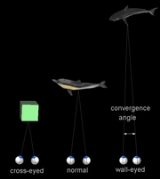
Vergence
Encyclopedia
A vergence is the simultaneous movement of both eye
s in opposite directions to obtain or maintain single binocular vision
..
 When a creature with binocular vision looks at an object, the eyes must rotate around a vertical axis so that the projection of the image is in the centre of the retina in both eyes. To look at an object closer by, the eyes rotate towards each other (convergence
When a creature with binocular vision looks at an object, the eyes must rotate around a vertical axis so that the projection of the image is in the centre of the retina in both eyes. To look at an object closer by, the eyes rotate towards each other (convergence
), while for an object farther away they rotate away from each other (divergence
). Exaggerated convergence is called cross eyed viewing (focussing on the nose for example) . When looking into the distance, the eyes diverge until parallel, effectively fixating the same point at infinity (or very far away).
Vergence movements are closely connected to accommodation of the eye
. Under normal conditions, changing the focus of the eyes to look at an object at a different distance will automatically cause vergence and accommodation.
As opposed to the 500°/s velocity of saccade
movements, vergence movements are far slower, around 25°/s. The extraocular muscles may have two types of fiber each with its own nerve supply, hence a dual mechanism.
Human eye
The human eye is an organ which reacts to light for several purposes. As a conscious sense organ, the eye allows vision. Rod and cone cells in the retina allow conscious light perception and vision including color differentiation and the perception of depth...
s in opposite directions to obtain or maintain single binocular vision
Binocular vision
Binocular vision is vision in which both eyes are used together. The word binocular comes from two Latin roots, bini for double, and oculus for eye. Having two eyes confers at least four advantages over having one. First, it gives a creature a spare eye in case one is damaged. Second, it gives a...
..

Convergence (eye)
In ophthalmology, convergence is the simultaneous inward movement of both eyes toward each other, usually in an effort to maintain single binocular vision when viewing an object. This action is mediated by the medial rectus muscle, which is innervated by Cranial nerve III...
), while for an object farther away they rotate away from each other (divergence
Divergence (eye)
In ophthalmology, divergence is the simultaneous outward movement of both eyes away from each other, usually in an effort to maintain single binocular vision when viewing an object. It is a type of vergence eye movement.-References:...
). Exaggerated convergence is called cross eyed viewing (focussing on the nose for example) . When looking into the distance, the eyes diverge until parallel, effectively fixating the same point at infinity (or very far away).
Vergence movements are closely connected to accommodation of the eye
Accommodation (eye)
Accommodation is the process by which the vertebrate eye changes optical power to maintain a clear image on an object as its distance changes....
. Under normal conditions, changing the focus of the eyes to look at an object at a different distance will automatically cause vergence and accommodation.
As opposed to the 500°/s velocity of saccade
Saccade
A saccade is a fast movement of an eye, head or other part of an animal's body or device. It can also be a fast shift in frequency of an emitted signal or other quick change. Saccades are quick, simultaneous movements of both eyes in the same direction...
movements, vergence movements are far slower, around 25°/s. The extraocular muscles may have two types of fiber each with its own nerve supply, hence a dual mechanism.
Vergence dysfunction
A number of vergence dysfunctions exist:- Basic exophoriaExophoriaExophoria is a form of heterophoria in which there is a tendency of the eyes to deviate outward. During examination, when the eyes are dissociated by prisms, the visual axes will appear to diverge away from one another.-Prevalence:...
- Convergence insufficiencyConvergence insufficiencyConvergence insufficiency or Convergence Disorder is a sensory and neuromuscular anomaly of the binocular vision system, characterized by an inability of the eyes to turn towards each other, or sustain convergence.-Symptoms:...
- Divergence excess
- Basic esophoriaEsophoriaEsophoria is characterised by inward deviation of the eye usually due to extra-ocular muscle imbalance.Causes include:*refractive errors*divergence insufficiency*convergence excess, these can be due to nerve, muscle, congenital or mechanical anomalies....
- Convergence excess
- Divergence insufficiency
- Fusional vergence dysfunction
- Vertical phoriaPhoriaPhoria is a 5-piece band from Brighton, with influences ranging from Radiohead and Elbow, to Sigur Rós and Cinematic Orchestra.In August 2010, Phoria released the anticipated E.P. 'Yourself Still' as a pay-what-you-want download . The success of this release has accelerated the production of the...
s
See also
- DuctionDuctionA duction is an eye movement involving only one eye. There are generally six possible movements depending upon the eye's axis of rotation:#Abduction refers to the outward movement of an eye.#Adduction refers to the inward movement of an eye...
- Extraocular musclesExtraocular musclesThe extraocular muscles are the six muscles that control the movements of the eye . The actions of the extraocular muscles depend on the position of the eye at the time of muscle contraction.-List of muscles:-Importance:...
- Eye movements
- Version (eye)Version (eye)A version is an eye movement involving both eyes moving synchronously and symmetrically in the same direction.#Dextroversion / right gaze#Laevoversion / left gaze#Sursumversion / elevation / up gaze#Deorsumversion / depression / down gaze...
- AutostereogramAutostereogramAn autostereogram is a single-image stereogram , designed to create the visual illusion of a three-dimensional scene from a two-dimensional image in the human brain...
- Eye examinationEye examinationAn eye examination is a battery of tests performed by an ophthalmologist, optometrist, or orthoptist assessing vision and ability to focus on and discern objects, as well as other tests and examinations pertaining to the eyes....
- Orthoptist

